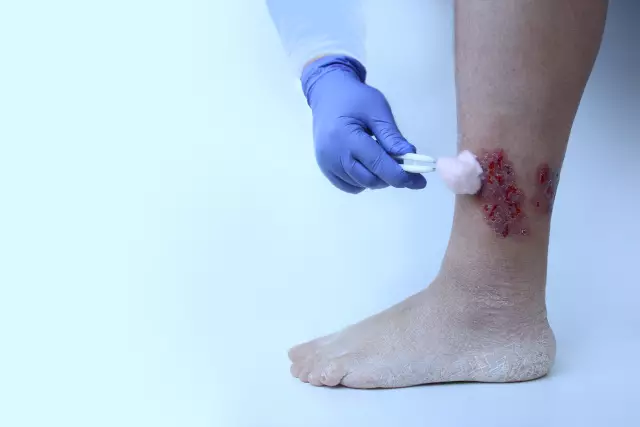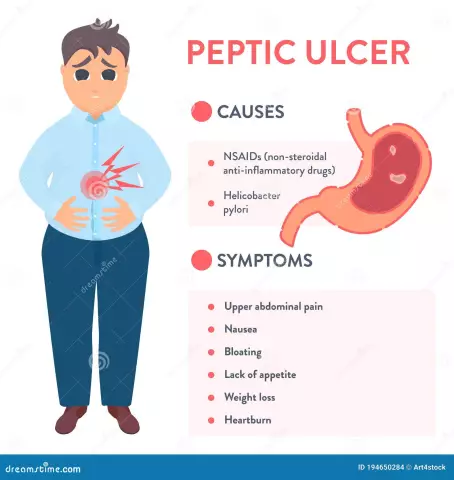- Author Rachel Wainwright [email protected].
- Public 2023-12-15 07:39.
- Last modified 2025-11-02 20:14.
Duodenum
The structure of the duodenum
The duodenum (duodenum) is the initial section of the small intestine, immediately following the pylorus (pylorus). Then this section of the intestine goes from left to right and somewhat posteriorly, turns down, descends along the front surface of the right kidney, turns to the left and, going up obliquely, passes into the jejunum. The name of this part of the intestine is associated with its length, which is exactly twelve across the fingers of the hand.

The anatomy of the duodenum is closely related to the biliary system as well as the pancreas. On the inner surface of the descending part of the duodenum is the papilla of the Vater (or large duodenal papilla). Here, through the sphincter of Oddi, the common bile duct, the pancreatic duct, opens (in some people, the pancreatic duct can directly flow into the common bile duct). The small duodenal papilla is located 8-40 mm above the large duodenal papilla. An additional pancreatic duct opens through it. This structure is anatomically variable.
The histological structure of the duodenal mucosa ensures the resistance of its epithelium to the aggressive composition of gastric juice, bile, and pancreatic enzymes.
Duodenal functions
One of the main functions of the duodenum is to bring the pH of the food gruel coming from the stomach to alkaline, which will not irritate the distal intestines and is suitable for carrying out the processes of parietal digestion. It is in this part of the intestine that the processes of intestinal digestion begin.
The second important function of the duodenum is the initiation and regulation of the enzymatic activity of the pancreas and liver, depending on the chemical composition and acidity of the incoming food gruel.
The third function of the duodenum is to regulate the reflex opening and closing of the pylorus, which depends on the acidity and chemical composition of the contents of this part of the intestine, as well as to regulate the acidity of gastric juice due to the secretion of humoral factors that provide the secretory activity of the stomach.
Diseases of the duodenum
The most common diseases of the duodenum are inflammation of the duodenum (duodenitis), duodenal ulcer, cancer (cancer of the duodenum).
Duodenitis
Duodenitis is an inflammation of the duodenum, namely its mucous membrane. The reason for the development of duodenitis is foodborne infections, poisoning with toxic substances that irritate the gastrointestinal mucosa, excessive consumption of spicy food, especially in combination with alcohol, damage to the mucous membrane by foreign bodies.
For inflammation of the duodenum, symptoms such as epigastric pain, weakness, nausea, vomiting, and fever are characteristic. Catarrhal and erosive-ulcerative form of duodenitis usually ends with self-healing within a few days, with repeated lesions, the process may become chronic. The complications of duodenitis include the development of acute pancreatitis, intestinal bleeding, perforation of the duodenal wall.
Treatment of duodenitis consists in adequate diet therapy, taking astringent and enveloping drugs, antispasmodics and anticholinergics.
Duodenal ulcer
A duodenal ulcer develops as a result of exposure to Helicobacter pylori infection. Hereditary factors, neuropsychic characteristics of a person, food factor, the influence of drugs, bad habits predispose to the development of this pathology. Symptoms of this disease are epigastric pain a few hours after eating, nighttime epigastric pain, heartburn, nausea, vomiting. Complications of the disease include bleeding, penetration, malignancy (development of a malignant lesion), pyloric stenosis, and perforation of the duodenal wall.
Treatment consists in taking anti-Helicobacter drugs (antibiotics, bismuth preparations), symptomatic therapy, diet therapy.
Duodenal cancer
Duodenal cancer is most often localized in the parapapillary region (descending section), less often in the upper or lower horizontal part. Duodenal cancer, in contrast to stomach cancer, is characterized by a low tendency to form metastases. Usually limited to regional lymph node involvement. A feature of the clinical picture of duodenal cancer is that a small tumor does not give symptoms, since it does not impede the passage of intestinal contents and does not cause intoxication. Consequently, symptoms occur when the tumor is sufficiently enlarged and the adjacent organs are compressed. Symptoms appear associated with a difficult flow of bile into the intestines: pain in the right hypochondrium, nausea, loss of appetite. When the pancreatic duct is compressed, pancreatitis of varying severity develops. With tumors of large sizes, the clinic is associated with the phenomena of stenosis: characterized by nausea, intestinal distention, stomach overflow, belching, heartburn. Common symptoms such as weight loss, anemia, and impaired appetite are characteristic. Successful treatment depends on the timely diagnosis of duodenal cancer. The treatment of this pathology is operative - circular resection of the affected part of the intestine, with peripapillary cancer, the large duodenal papilla, the pancreatic duct is also removed. The treatment of this pathology is operative - circular resection of the affected part of the intestine, with peripapillary cancer, the large duodenal papilla, the pancreatic duct is also removed. The treatment of this pathology is operative - circular resection of the affected part of the intestine, with peripapillary cancer, the large duodenal papilla, the pancreatic duct, is also removed.
Found a mistake in the text? Select it and press Ctrl + Enter.






